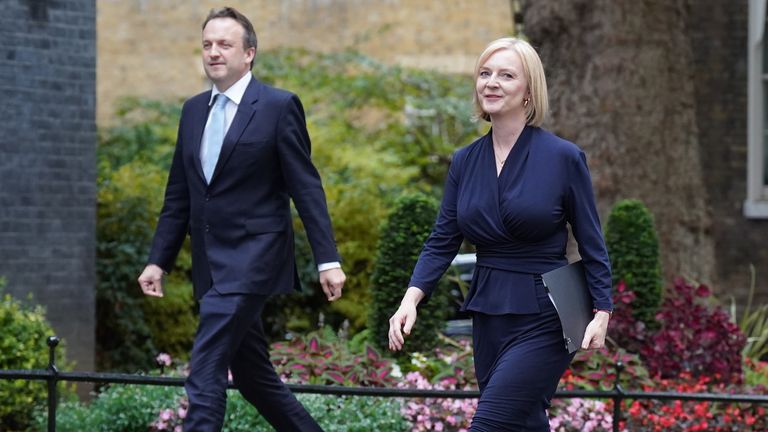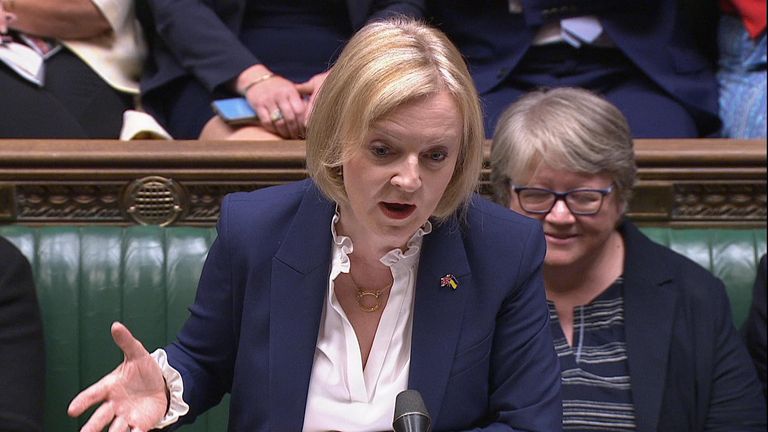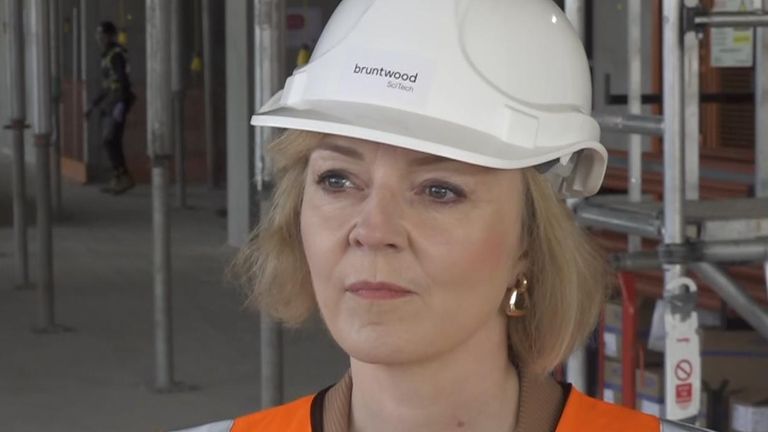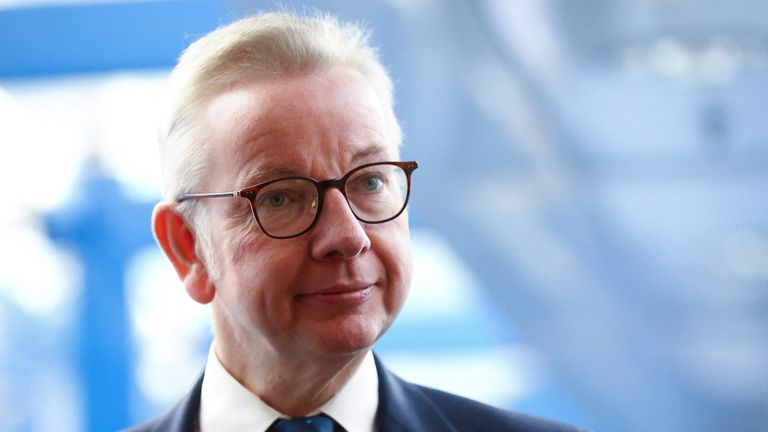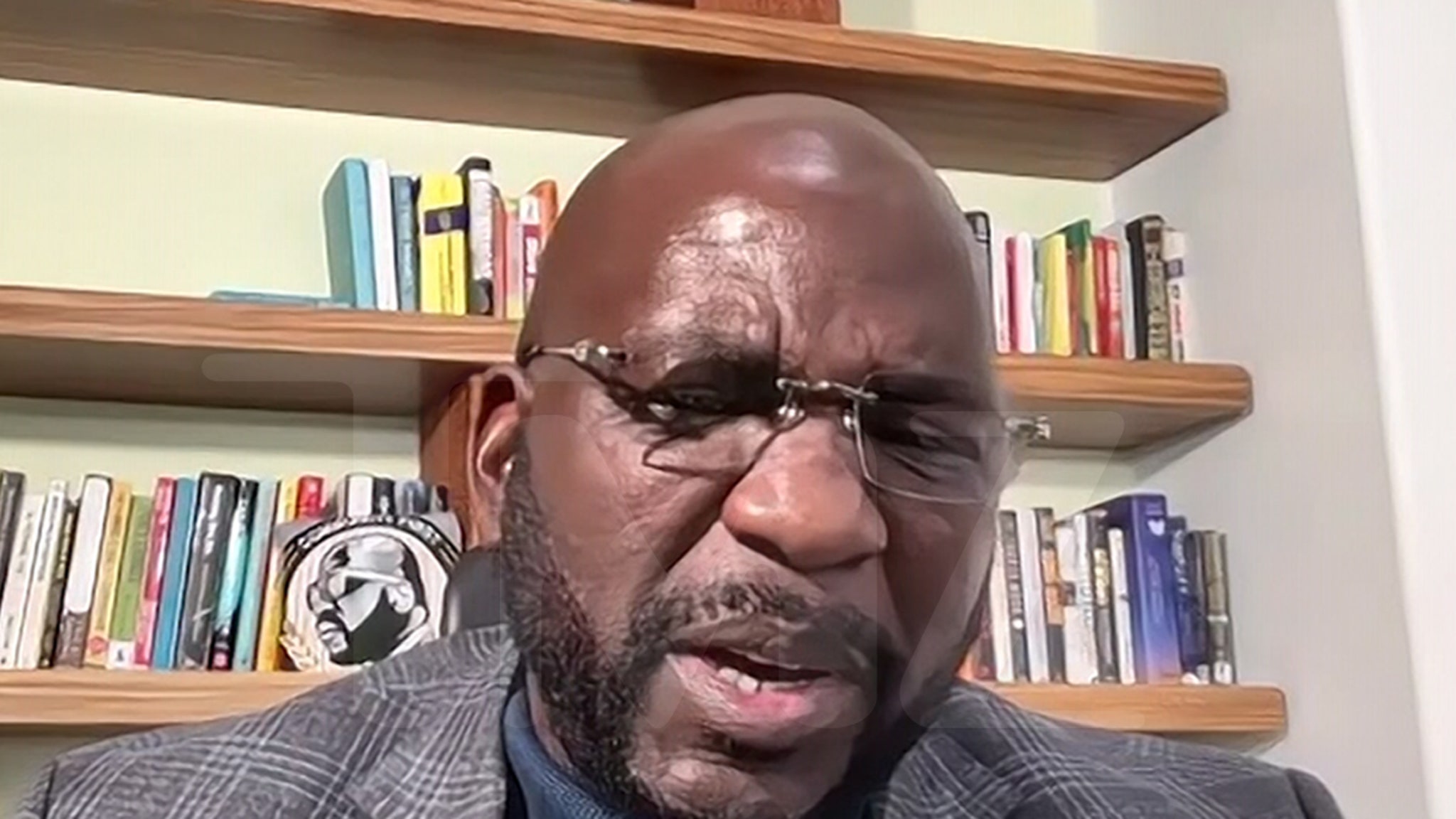The plane flying Liz Truss to meet the Queen at Balmoral for her appointment as prime minister a month ago was hit by turbulence in bad weather and struggled to land at Aberdeen airport.
The aircraft’s helpless circling in mid-air was seen at the time as a bad omen for her premiership.
And after a month of mayhem for the new PM, perhaps it was indeed a warning of trouble ahead.
Politics live: Truss takes aim at ‘anti-growth coalition’ in pivotal speech
In the month since Ms Truss was confirmed as Tory leader, her leadership has faced the death and mourning of the Queen, a bungled budget, markets chaos, U-turns, polls suggesting a Labour landslide and a backbench “coup” against her.
Her response, in a fighting and defiant speech at the end of a fractious and chaotic Tory conference in Birmingham, was to declare: “Whenever there is change, there is disruption. And not everyone will be in favour of change.”
Let’s take a look at the key dates in this rocky start in Number 10.
Monday 5 September
Much has changed dramatically since Ms Truss defeated Rishi Sunak for the Conservative crown by 57.4% to 42.6% – a comfortable margin, but slimmer than in other recent Tory leadership elections.
In her victory speech at London’s Queen Elizabeth II conference centre, she described the contest as “one of the longest job interviews in history”.
She praised her predecessor, Boris Johnson, and said: “You got Brexit done. You crushed Jeremy Corbyn. You rolled out the vaccine and you stood up to Vladimir Putin.”
Tuesday 6 September
Safely back from stormy Balmoral, Ms Truss strode up Downing Street with her slightly bemused looking husband Hugh O’Leary and told the nation: “Together we can ride out the storm.”
But the political – and economic – storm, already becoming perilous for the new PM because of soaring energy prices, was only just beginning.
Although her swift cabinet reshuffle contained few surprises and her appointments had been widely predicted, it was a brutal purge of those ministers who had backed her leadership rival, Mr Sunak.
Into the top jobs came her most loyal allies and backers: Therese Coffey, Kwasi Kwarteng, James Cleverly, Suella Braverman, Jacob Rees-Mogg, Nadhim Zahawi and Brandon Lewis.
Banished to the backbenches were Michael Gove, Grant Shapps, Sajid Javid and many more, in a cull that began to backfire badly at this week’s Tory conference, when Mr Gove and Mr Shapps led the mutiny on the 45p tax cut.
Wednesday 7 September
In an eagerly awaited first Prime Minister’s Questions for the new premier, Ms Truss put in a sound performance and delighted Tory backbenchers with her counter-attacks against Sir Keir Starmer.
When the Labour leader demanded a windfall tax on energy giants to fund her plans to help families pay soaring energy bills, she gave her now familiar answer: “We cannot tax our way to growth.”
Thursday 8 September
The pivotal moment in the PM’s month of mayhem came when she was passed a note by Cabinet Office Minister Nadhim Zahawi as she delivered her Commons statement on her £150bn package to freeze energy bills.
The news in the note – that the Queen was gravely ill just two days after Ms Truss had been to see her at Balmoral to be appointed prime minister – stunned Westminster and put politics into suspension for 11 days.
After the announcement of the Queen’s death at 6.30pm, the new PM appeared in Downing Street in a black dress and, with her voice quivering with emotion, paid a solemn tribute to the monarch.
The Queen was “the rock on which modern Britain was built”, she said, and her death was a huge shock to the country and the world.
She said the Queen’s sense of duty had been a personal inspiration to her and many other Britons, adding: “She was the very spirit of Great Britain and that spirit will endure.”
9 to 19 September
With the nation still reeling from the shock of the Queen’s death, the PM led two days of tributes in Parliament, telling MPs: “In the hours since last night’s shocking news, we have witnessed the most heartfelt outpouring of grief at the loss of her late majesty the Queen.
“Crowds have gathered, flags have been lowered to half-mast, tributes have been sent from every continent around the world.”
And after King Charles’ accession to the throne the following day, Ms Truss travelled to Edinburgh, Belfast and Cardiff as the new King attended cathedral services to honour his late mother’s life.
She attended her first formal audience with the new King, a meeting where it has been claimed she advised him not to attend the COP27 climate change summit in Egypt next month – a claim dismissed as “ridiculous” by 10 Downing Street.
At the Queen’s funeral she read a lesson from St John’s gospel. But as she arrived at Westminster Abbey with her husband, she would have been unaware that two Australian broadcasters commentating on the funeral mistook her for a “minor royal”.
20 and 21 September
After the Queen’s funeral, Ms Truss made a whirlwind visit to the United Nations General Assembly – a regular date in the September calendar for prime ministers, but a stern test for one only in office for two weeks.
As a newcomer, she had a middle-of-the-night graveyard slot in the speeches and at her first face-to-face meeting with Joe Biden was confronted by the US president on the Northern Ireland Protocol.
“We are both committed to protecting the Good Friday Agreement of Northern Ireland and I’m looking forward to hearing what’s on your mind,” he challenged her pointedly.
Friday 23 September
Back in London, the PM sat alongside her “dynamic new chancellor”, as she called him in her conference speech, Kwasi Kwarteng, as he delivered his delayed “growth plan”.
In a clumsy remark at the Tory conference, he appeared to blame the Queen’s death for the furore it provoked.
“Literally four days after the funeral, we had the mini-budget,” he said. “It was a high-speed, high pressure environment.”
The growth plan was a disaster.
Mr Kwarteng’s £45bn tax-cutting package for the rich sent the pound crashing to its lowest level against the dollar in 37 years. He announced more than £400bn of extra borrowing over the coming years to fund the biggest giveaway since Anthony Barber’s ill-fated 1972 budget.
He scrapped the 45% rate of income tax paid by those earning more than £150,000 a year, abolished the cap on bankers’ bonuses, reversed the rise in National Insurance contributions and brought forward by a year the reduction in the basic rate of income tax from 20% to 19%, pencilled in by Mr Sunak for 2024.
The respected Paul Johnson of the Institute for Fiscal Studies reacted: “The chancellor announced the biggest package of tax cuts in 50 years without even a semblance of an effort to make the public finance numbers add up.
“Instead, the plan seems to be to borrow large sums at increasingly expensive rates, put government debt on an unsustainable rising path and hope that we get better growth. Mr Kwarteng is not just gambling on a new strategy, he is betting the house.”
The Daily Mail cooed: “At last! A true Tory budget.” But the generally Tory-supporting Economist said the government’s reckless incompetence may have already damaged it beyond repair.
Monday 26 September
After Mr Kwarteng said in a TV interview there were more tax cuts to come, the pound plunged even further.
The turmoil was a gift to Labour, enjoying a largely successful conference in Liverpool.
Thursday 29 September
But if the run on the pound was bad, worse was to come. The Bank of England was forced to calm the bond market with a £65bn bailout after a surge in gilt yields threatened to wipe out many pension funds.
At the same time, a YouGov opinion poll gave Labour a massive 33-point lead over the Conservatives, suggesting a vote share of 54% for Sir Keir’s party and just 21% for the Tories.
It was the biggest Labour lead since Tony Blair’s honeymoon period in the months after his 1997 general election landslide.
The current Labour leader called for the recall of parliament to address the financial crisis. He urged the government to abandon the mini-budget measures which triggered the market turmoil and said the PM was a “danger” to the economy and has lost control.
Sunday 2 October
As the Tory conference opened in Birmingham, Ms Truss was accused of “throwing Mr Kwarteng under a bus” over the 45% tax fiasco and distancing herself from it when she said in an interview: “It was a decision that the chancellor made.”
As a backbench mutiny reached dangerous levels, with some leading backbenchers even claiming the PM could be ousted within weeks, she performed a humiliating late-night U-turn which was revealed to bemused and shell-shocked cabinet ministers in the early hours of Monday morning.
After Mr Kwarteng confirmed his embarrassing retreat at 7.30am, in what looked like another snub the PM was asked three times if she trusted her chancellor but failed to declare her support for him.
Later, a sweating Mr Kwarteng gave an unconvincing conference speech, which was described as more trite than contrite.
Tuesday 4 October
As she came to the end of her first month as PM, Ms Truss’s decision to sack so many heavy hitters was coming back to bite her as the Tory conference descended into a bitter civil war.
After Michael Gove launched a series of highly targeted attacks against the cut to the 45p tax rate, the spurned Grant Shapps declared that she may have as little as 10 days to salvage her premiership and the next few days were the “critical period” for her to turn things around.
Nadine Dorries, previously an enthusiastic Truss supporter, accused her of tearing up the Tory manifesto and called for a general election. Then Priti Patel accused the government of “spending today with no thought for tomorrow”.
But even worse, the bickering spread to inside the cabinet, with Leader of the Commons Penny Mordaunt backing those demanding the bigger benefit increase, then Welsh Secretary Robert Buckland weighing in too.
Amid the open warfare, the new Home Secretary Suella Braverman had accused rebels of mounting a “coup” against the PM on the 45% tax cut, an attack that inflamed the dissent on the backbenches.
Wednesday 5 October
In a combative fightback Ms Truss took to the stage on the final day of conference and declared war on an “anti-growth coalition”.
Thursday 6 October
Ms Truss is beginning her second month as prime minister flying to Prague for a meeting with European leaders to galvanise the response to Vladimir Putin’s invasion of Ukraine.
And unlike her bumpy journey to Balmoral a month ago, she’ll be hoping for a smooth, turbulence-free flight this time, and no more omens of another month of mayhem.

